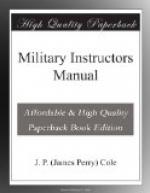DUTIES: (235, i.d.r.)
1. One Bugler—
a. Observes
the enemy.
b. Observes
the target.
c. Observes
for fire effect.
d. Watches
platoon leaders for signals.
e. Transmits
signals to platoon leaders.
2. The other—
a. Watches
the Major for signals and repeats them back.
b. Transmits
information to the Major.
3. BOTH—
a. Repeat
bugle signals “charge.” (319, i.d.r.)
b. Carry
field glasses, message pads, pencils and signal flags.
(i.u.a.e.m.,
387, i.d.r.)
c. Act as
messengers.
ALL OF THE ABOVE IMPLIES THAT THEY
MUST BE PROFICIENT IN:
a. Signaling—Hand, Arm and Letter
Codes.
b. Observation for fire effect.
c. Location and definition or description
of targets.
d. Bugle calls.
VI. RANGE ESTIMATORS.
Five or six officers or men, selected from the most accurate estimators in the company are designated “Range Finders.” (240, i.d.r.)
The term “Range Finder” is a misnomer as a range finder is an instrument. The school uses the term “Range Estimator” when applied to an individual. The attention of the War Department has been called to this.
The range estimators are given special training in the estimation of ranges.
When an action is pending, the Captain receives from the Major the primary apportionment of the target or sector of fire. (303, i.d.r.)
The Captain returns to the company, and, avoiding dangerous grouping, assembles the platoon leaders and range estimators, and points out to both the target of the Battalion and Company.
The Range Estimators immediately begin their estimation of the range to the company target; the Captain meanwhile continues with his instructions to the Platoon Leaders.
The instructions to the Platoon Leaders completed, the Range Estimators announce to the Captain either their individual estimates, or the mean of their estimates as deduced by one of the estimators. The Range Estimators then take their customary posts (240, i.d.r.), and the Captain indicates to the Platoon Leaders the range to be used.
The Range Estimators act in an advisory capacity to the Captain. The mean of their estimates will usually be the most accurate deduction available in battle. The adoption by the Captain of the range thus determined, however, is not obligatory.
Range Estimators should be ready to signal their estimates of the range to the platoon leaders at any time during the action.
VII. THE PLATOON LEADER.
(The Fire Controller.)
POSITION: Where he can best:
1. Control the squads constituting
his platoon. (252, i.d.r.)
2. Observe the target and fire
effect. (252, 414, 415, i.d.r., and
216, s.a.f.m.)
3. Observe the captain for
signals or commands. (234, 251, i.d.r.)




